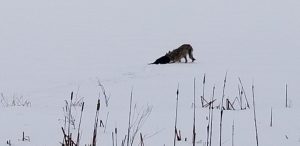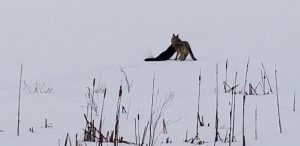OUT of DOORS with BARNEY MOORHOUSE For Reproduction Rights Call Access 1.800.893.5777
ABOUT FLOODS
Last week I introduced Les Stanfield and his informed opinion regarding flooding and a possible solution. The creation of Conservation authorities was inspired by Hurricane Hazel. Their reactive approach was to build dams and plan to avoid similar future tragedies. But somewhere along the line developers were permitted to build on flood plains and swamps were filled in by landowners. Memories are short.
“Expanded upstream urbanization and agricultural intensification almost everywhere have increased the rate and volume of water entering rivers. Many rivers have now surpassed their capacity to process these flows.” (Stanfield) He continues to say that economic pressures have forced farmers to increase crop yields from limited acreage causing them to drain or fill in marshy land. Urbanization has hardened the land causing it to lose the ability to soak up and retain water. Forestry practices are also important regarding water retention.
“The flood control plans that have largely worked for the past 30 years are no longer working because that flood forecasting doesn’t consider the impact of these largely undocumented actions by farmers and developers.” (Stanfield)
The mismanagement of thousands of small waterbodies in the watersheds, such as swamps and marshes and their ability to retain water is basically “unmapped”. (Stanfield)
Filling in marshland along the York has intensified channelization thus increasing the water runoff sending more nutrients and sediments downstream, not to speak of flooding damage by diminishing the blotter-like effect of swamps and marshes to retain water for the drier summer months instead of flushing it away during the spring run-off.
Stanfield suggests that all levels of government must work together. Failure to do so will only result in making the problem worse for entire watersheds. To say it is all due to climate change is too simplistic.
AN UNUSUAL SIGHT

Sunday, March 10, 2019 at approximately 1:00 p.m. Wayne Jarmuth and Grace Brown were northbound on The Ridge Road, just east of the hamlet of Coe Hill. Peripherally something caught Jarmuth’s eye. It was a coyote, about 20 yards off the roadway, and it had something rather dark and large in its mouth. Turned out to be a beaver.
“The coyote obviously had just captured the beaver, as it came out of a hole in the ice, at the beaver dam, which is just beside the road at this point.” The beaver’s tail was “flailing wildly.” According to Jarmuth the beaver pond is on the east side of The Ridge Road, just north of Urbach Lake Lane.
Jarmuth and Brown watched the coyote drag the beaver off to the east, stopping now and then to “plunge its jaws into the neck of the beaver, I suppose, trying to break its neck and subdue the beaver.”
All captured on a cell phone.
Our mutual friend the legendary nonagenarian Bill O’Brien was suitably impressed and kindly recommended that I might like to see this. As I presume, would readers of this column.

As I said to Wayne, you can’t catch such sights sitting on a couch.
Does one ever become bored with nature? That’s a rhetorical question lest you were wondering. By the by, speaking of interesting, Ashlie’s book store in Bancroft is selling The Book about Bill O’Brien penned, I believe, by his family. Haven’t had a chance to review it as yet.
BLOWING IN THE WIND
There are about 2.5 million leaf blowers in use in Canada and more than 130 million in the U.S. Retired chemical engineer Monty McDonald has been campaigning for a leaf blower ban for years because they cause both noise and air pollution.
McDonald worked with potential carcinogens in a chemical plant where worker safety was a top priority. “We got the levels in that plant down to 10 parts per million in the workplace, which was the OSHA [Occupational Safety and Health Administration] standard at that time,” he said. “Now you stand near a leaf blower and you’re probably getting 10,000 parts per million exposure to hydrocarbons that are in gasoline and oil, and many of them are carcinogens.” Such as benzene, butadiene, and formaldehyde.
“Thirty per cent of fuel is unburned and goes out into the atmosphere as an aerosol,” McDonald said. “If you’re smelling it, you’re ingesting it.” The air from the blower travels at 200km per hour and pulverizes what it hits into fine dust (soil, fertilizer, moulds, animal excrement, toxic street dust) that can stay airborne for days. Much of this dust is so fine (less than 10 microns), it gets past the protective cilia in your airway and passes into your lungs; some very fine particles can get into your bloodstream.
The noise is also harmful, he explains, because it’s at a low frequency and easily penetrates the walls and windows of peoples’ homes and ear protectors. Leaf blowers are the biggest obnoxious noise source in the city of Toronto (noise as high as 115 decibels). Under 75 is considered safe. Books have been written on the health effects of noise.
Many people are ambivalent about a ban on the use of the leaf blower McDonald believes because of the view that “since the government is allowing it, it must be okay.”
AND FINALLY…
“A closed mouth gathers no foot.” (Anon)
Photos – courtesy Wayne Jarmuth.
